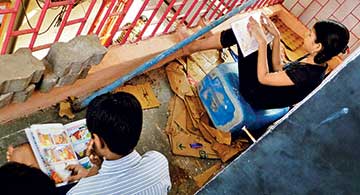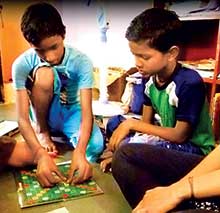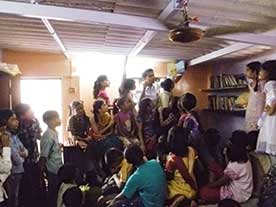Anish Nair
One Saturday afternoon, two years ago, my colleague Prachur Goel and I discussed the idea of a larger impact on the people around us. We were teachers in a low-income private school in Kamraj Nagar, a slum community adjoining the Eastern Express highway in Mumbai. Given the short duration of our fellowship, we thought about doing something that would have an effective footprint, not only on the kids we taught, but also on the entire community.
We had achieved considerable success with our first year of teaching. Students had improved significantly in language and math, in a period of one year. However, when these students resumed studies after a two month vacation, they were found to be lacking in the same skills they had trumped not long ago. One reason why our kids were reading much below their supposed grade level was that their exposure to print after they left school was negligible. Their only print sources were their school textbooks. No newspapers, no comics. Textbooks can be boring and some of the content is too high for independent reading. Some books just did not inspire interest. Also, we wanted to assemble a place where kids could spend their afternoons learning about something productive. We wished to find a place outside the school premises, since this would give us greater autonomy and also access to a wider section of the community. Thus began our ‘Be the Change’ project.
We did an extensive survey of about 50 families, carried out adequate research, spoke to parents and searched for places in the slum to open a reading room. Accessibility was a major concern. So was protection from rain (flooding and leakage). After months of deliberation, hunting and talks, we finally decided upon a place.
 We gathered funds through our collective GiveIndia page. Several people stepped forward and contributed generously. A lot of them contributed with books and stationery. Students of Bombay International school went ahead and even conducted a drive for us. We acquired encyclopedias, story books, puzzles and novels. We had the rented place re-painted. We also bought wooden shelves. One of the sponsors even agreed to pay a part of the annual rent.
We gathered funds through our collective GiveIndia page. Several people stepped forward and contributed generously. A lot of them contributed with books and stationery. Students of Bombay International school went ahead and even conducted a drive for us. We acquired encyclopedias, story books, puzzles and novels. We had the rented place re-painted. We also bought wooden shelves. One of the sponsors even agreed to pay a part of the annual rent.
Every day, there was a long line outside the gate when we went to open the reading room at 2 pm. We had trouble keeping the kids out. Children were allowed access to the reading room conditionally. These were the same students who had no books at home and would read reluctantly. We had succeeded in our mission to get them interested to come to a place full of books and read. They just wouldn’t leave.
Our reading room has a lot of story books. We had consciously stocked our reading room with content heavy books on science, geography, math and history. But most students did not read these content heavy books. One reason for the reading room was to make students take responsibility for their own learning by providing them an avenue where resources are available. We brainstormed quite a lot about how to get our students to extract information out of the books. We came up with projects on science, history, geography and math. The projects would compel the students to explore the content books and create solutions.
Over time, the story of our reading room spread. Parents were eager to send their kids to the reading room. Not only that, students started coming with their siblings. They used to spend their time voraciously gobbling books or playing educational games. With the help of volunteers from India and abroad, we started conducting mini-workshops and storytelling sessions. I conducted a storytelling session for 100 students. We also held movie sessions with the help of a projector.
We have had our share of difficulties as well, largely due to the fact that we did not have proper library experience or training. It would be difficult to pay undivided attention to kids who needed intervention while reading. Also, categorizing the books took us a fair amount of time. Parents of girls needed to be convinced personally that spending time at the reading room had a better long-term ROI than helping out with household chores.
 We invited parents to join their kids in the library. Some obliged. They were keen to observe the progress their kids were making, meanwhile enjoying reading themselves. Our students also accompanied us to several book fairs, where we would allow them to pick up books of their choice, which would then become a part of the reading room. Sustainability was also a major concern for us. Towards the end of our fellowship, we decided to pass the mantle of the reading room supervisor to a few senior students in the school, thus giving them the opportunity to learn and earn at the same time.
We invited parents to join their kids in the library. Some obliged. They were keen to observe the progress their kids were making, meanwhile enjoying reading themselves. Our students also accompanied us to several book fairs, where we would allow them to pick up books of their choice, which would then become a part of the reading room. Sustainability was also a major concern for us. Towards the end of our fellowship, we decided to pass the mantle of the reading room supervisor to a few senior students in the school, thus giving them the opportunity to learn and earn at the same time.
Once, Shruti (our other brilliant colleague) told a few students to write about the reading room. Here’s Muskan, one of our bright kids, in her own words describing ‘our’ reading room.
Our reading room
Our beautiful, little reading room with a small door painted in red colour above Mahalaxmi Dairy, is every child’s dream come true. And it is located in Kamraj Nagar.
 Prachur Goel and Anish Nair, our Bhaiyas, started the reading room in September 2012. First, Bhaiya gave every student reading room pass. Our reading room is small but it is filled with books. Every book were keep in order wise on the shelf.
Prachur Goel and Anish Nair, our Bhaiyas, started the reading room in September 2012. First, Bhaiya gave every student reading room pass. Our reading room is small but it is filled with books. Every book were keep in order wise on the shelf.
Because in our reading room there are many shelves and one balcony. Reading room starts at 2 o’clock till 5 o’clock. And I had notice mostly girls come in the reading room to study. And generally girls and boys were interesting in puzzles. And I had also notice every time on Prachur Bhaiya’s mouth there is motto for books. And the motto is “Keep as it is.”
Prachur Bhaiya and Anish Bhaiya and both Didis (Neha Soneji and Shruti Murali) are in the reading room with many new Didis and Bhaiyas come from international countries to see our reading room and join us in studying. Every day we do something new in the reading room like brief description, talking about new arrivals etc. In reading room, my most favourite book is “The Banana Robber and other stories” written by Enid Blyton.
Today, you can walk up the Kamraj Nagar street and ask a kid directions to the ‘library’. I am sure they will be able to guide you. The reading room is in its second year now and is going strong. The current Teach For India fellows are responsible for its maintenance and administration, along with the senior students. We strongly believe this ‘library-cum-reading room’ will influence the lives of many people in the community, kids and adults alike.
The author is a Teach For India Fellow, responsible for bridging the achievement gap of 115 students (Grades 4 and 5) in a low-income private school in Kamraj Nagar, Mumbai from 2011-13. Currently, he works for an organisation called Bridge International Academies. He can be reached at anish.nair2011@teachforindia.org.
Related articles
Multiple roles, many responsibilities
A space for teacher-leaders
Discovering new horizons
A rewarding experience
Learning by doing
The world outside
